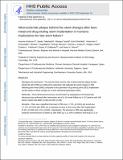Atherosclerotic plaque behind the stent changes after bare-metal and drug-eluting stent implantation in humans: Implications for late stent failure?
Author(s)
Takahashi, Saeko; Tsuda, Masaya; Shishido, Koki; Mizuno, Shingo; Coskun, Ahmet U.; Saito, Shigeru; Feldman, Charles L.; Stone, Peter H.; Andreou, Ioannis; Antoniadis, Antonios; Papafaklis, Michail; Edelman, Elazer R; ... Show more Show less
Downloadnihms806345.pdf (571.5Kb)
PUBLISHER_CC
Publisher with Creative Commons License
Creative Commons Attribution
Terms of use
Metadata
Show full item recordAbstract
Background and aims The natural history and the role of atherosclerotic plaque located behind the stent (PBS) are still poorly understood. We evaluated the serial changes in PBS following bare-metal (BMS) compared to first-generation drug-eluting stent (DES) implantation and the impact of these changes on in-stent neointimal hyperplasia (NIH). Methods Three-dimensional coronary reconstruction by angiography and intravascular ultrasound was performed after intervention and at 6–10-month follow-up in 157 patients with 188 lesions treated with BMS (n = 89) and DES (n = 99). Results There was a significant decrease in PBS area (−7.2%; p < 0.001) and vessel area (−1.7%; p < 0.001) after BMS and a respective increase in both areas after DES implantation (6.1%; p < 0.001 and 4.1%; p < 0.001, respectively). The decrease in PBS area significantly predicted neointimal area at follow-up after BMS (β: 0.15; 95% confidence interval [CI]: 0.10–0.20, p < 0.001) and DES (β: 0.09; 95% CI: 0.07–0.11; p < 0.001) implantation. The decrease in PBS area was the most powerful predictor of significant NIH after BMS implantation (odds ratio: 1.13; 95% CI: 1.02–1.26; p = 0.02). Conclusions The decrease in PBS area after stent implantation is significantly associated with the magnitude of NIH development at follow-up. This finding raises the possibility of a communication between the lesion within the stent and the underlying native atherosclerotic plaque, and may have important implications regarding the pathobiology of in-stent restenosis and late/very late stent thrombosis.
Date issued
2016-07Department
Massachusetts Institute of Technology. Institute for Medical Engineering & ScienceJournal
Atherosclerosis
Publisher
Elsevier
Citation
Andreou, Ioannis et al. “Atherosclerotic Plaque Behind the Stent Changes after Bare-Metal and Drug-Eluting Stent Implantation in Humans: Implications for Late Stent Failure?” Atherosclerosis 252 (September 2016): 9–14 © 2016 Elsevier Ireland Ltd
Version: Author's final manuscript
ISSN
0021-9150